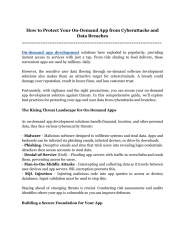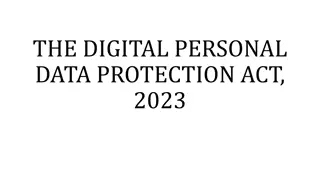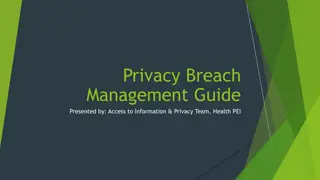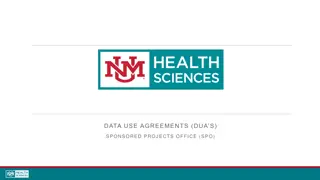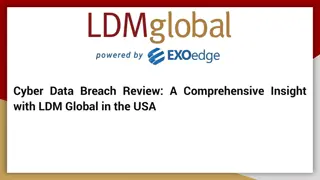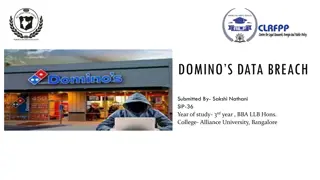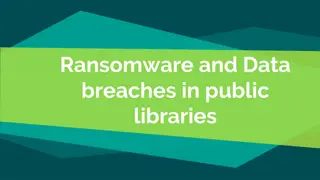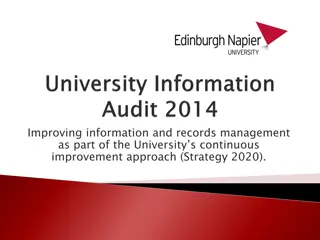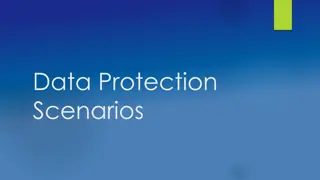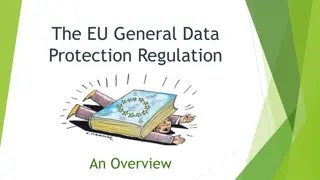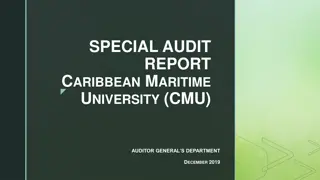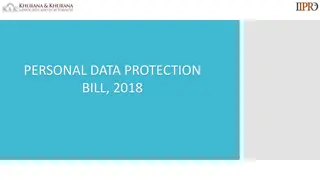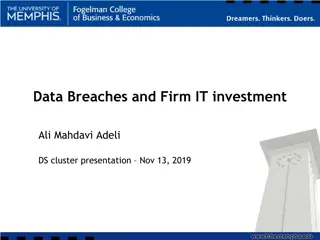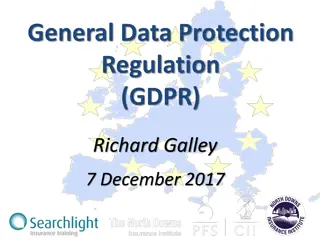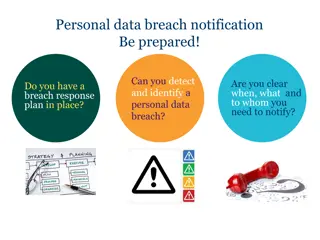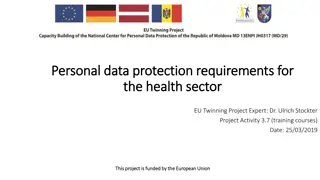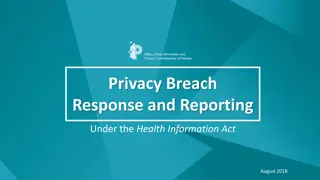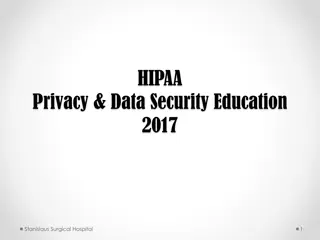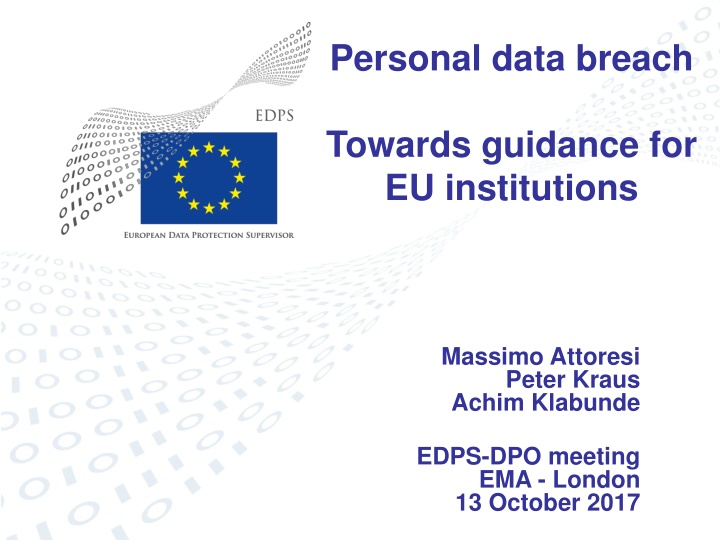
Personal Data Breaches in EU Institutions
This document discusses personal data breaches within EU institutions, covering topics such as legal requirements, guidance, procedural needs, case studies, and incident management procedures. It explains the scope and purpose of the workshop and delves into the legal basis, definitions, and security aspects of personal data breaches. The content emphasizes the importance of accountability and the role of Data Protection Officers in informing about breaches.
Download Presentation

Please find below an Image/Link to download the presentation.
The content on the website is provided AS IS for your information and personal use only. It may not be sold, licensed, or shared on other websites without obtaining consent from the author. If you encounter any issues during the download, it is possible that the publisher has removed the file from their server.
You are allowed to download the files provided on this website for personal or commercial use, subject to the condition that they are used lawfully. All files are the property of their respective owners.
The content on the website is provided AS IS for your information and personal use only. It may not be sold, licensed, or shared on other websites without obtaining consent from the author.
E N D
Presentation Transcript
Personal data breach Towards guidance for EU institutions Massimo Attoresi Peter Kraus Achim Klabunde EDPS-DPO meeting EMA - London 13 October 2017
Overview State of play Legal requirements Guidance in preparation Procedural needs Case studies 2
Scope and purpose of this workshop With review of Regulation 45/2001, mandatory data breach notification will apply to EUIs. Currently good practice , in future legal obligation. Plan for this workshop: No in depth discussion on incident severity assessment methodology today (next time?) 3
Legal basis Definition in GDPR - Art. 4(12) + Art. 37 and 38 of the proposed Regulation Art 37 Notification of a personal data breach to the EDPS Art 38 - Communication of a personal data breach to the data subject Recitals 45, 46 and 37 (possible restriction in the communication to data subjects based on EU law and institutions decisions under certain conditions) References in Art. 46 (DPO), 59 (EDPS powers) 4
What is a personal data breach ? An information security breach, leading to the compromise of CONFIDENTIALITY and/or AVAILABILITY and/or INTEGRITY of personal data under the responsibility of the EU institution as a controller If the Regulation is breached in a different way (e.g. no adequate legal basis, no notice to data subjects etc.) this is NOT a PDB ! 5
Security Overall information security management Security incident management procedure Usually all types of information in scope If personal data are affected, it is part of the technical and organisational measures of Art. 33 and of the obligation of data protection by design and by default. Need to integrate/plug-in specific data protection requirements into the incident management procedure 6
Incident management procedure Plan & Preparation Review and improvement Initial assessment Detailed assessment & evidence collection Containment & recovery Always focus and priority on the protection of data subjects ! 7
Accountability EUI to inform their DPO ... in any case liaise with your Security Officer on a permanent basis EUI to document personal data breach: facts, effects, remedial and notification actions, including rationale for decisions and relevant evidence for future references.... for EDPS to verify compliance Processor to assist the controller 8
Step by step duty perspective for controllers High risk Communication to data subjects Notification to the EDPS Risk Accountability & Security Always 9
Notification to the EDPS - 1 In what circumstances? Personal data breach likely to result in a risk to the data subject. What? Nature of breach Categories of data and approx. n of records Categories of data subjects and approx. n Likely consequences Measures planned/taken Contact details of the DPO or other contact point 10
Notification to the EDPS - 2 When ? Without undue delay, not later than 72 h after the institution becomes aware Phased notifications Possibility of a delayed notification need for proper reasons Role of processor To notify the EUI without undue delay Assist EUI with all necessary means and providing the necessary info in due time 11
Information to data subjects - 1 In what circumstances? Personal data breach likely to result in a HIGH risk to the data subject. When ? Without undue delay Exemptions: Appropriate measure prior to the breach Steps to reduce or avoid high risk Disproportionate effort Possible restrictions (public interest, prejudice to other individuals etc.) as in EU law or EUI decision How ? Dedicated, direct, effective (multiple) channels maximising chances to target affected individuals Clear and plain language Possible alternative formats, many languages 12
Information to data subjects - 2 What ? Nature of breach Contact details of the DPO or other contact point Likely consequences Measures planned/taken What else? Advice to individuals as to what is in their capability to protect themselves from adverse effects (e.g. password reset, use of alternative communication channels etc.) 13
Assessment of risks to data subjects - 1 Risk: based on potential severity and likelihood What type of breach? What data? Personal data? Special categories of personal data? How many data subjects? How much data? Relation to other personal data? Chance of identification 14
Assessment of risks to data subjects - 2 Mitigating measures? Was the data encrypted? Anonymized or pseudonymized? Which freedoms and rights are affected? Severity for the data subject? Taking into account especially: Special characteristics: vulnerable individuals? Characteristics of the data controller? 15
DPO role Provide advice on necessity of Personal Data Breach notification, where requested Recommend mitigation measures Contact person for data subjects Contact person for the EDPS Liaise with Security Officers on Info Security Risk Management and data breach policy 16
Case studies ! ! Disclaimer: The following examples are inspired by real events but are slightly adapted. Any reference to real persons or authorities therefore is unintended and accidental. 17
Case studies - 1 Case Study 1: DPO for a DG DG is moving to another building Movers find locker of Archive open Multiple folders missing. Folders contain among others Health data However: You have a digital backup 18
Case studies - 2 Case Study 2: DPO for an Agency Background: Running your own infrastructure File servers backup data each day to backup servers in the network Incident Colleague describes panicking a computer malfunction: ransomware ! Personal USB Stick used before incident happens Further development (after 30 minutes): Colleagues cannot access data from the file server 19
Case studies - 3 Case Study 3: DPO for an Institution Background: Budget cuts: search for cheaper IT solutions Incident Colleague uploads data to private cloud service to test performance Data set consists of a large working folder of this colleague 20
Case studies - 4 Options: 1. Data stored unencrypted on the cloud service provider s (CSP) platform 2. Data AES-512 encrypted, key on local file system Development: After one year: CSP has been hacked. CSP notifies: user data has been accessed. Development 2 : (only if data are encrypted) After another year: LISO informs you of network breach Encryption keys have been accessed 21
Thank you for your attention! www.edps.europa.eu edps@edps.europa.eu @EU_EDPS

